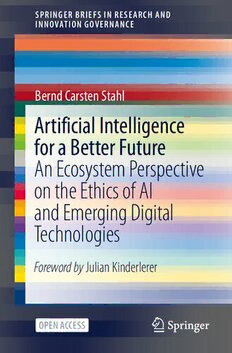
Artificial Intelligence for a Better Future: An Ecosystem Perspective on the Ethics of AI and Emerging Digital Technologies PDF
Preview Artificial Intelligence for a Better Future: An Ecosystem Perspective on the Ethics of AI and Emerging Digital Technologies
SPRINGER BRIEFS IN RESEARCH AND INNOVATION GOVERNANCE Bernd Carsten Stahl Artificial Intelligence for a Better Future An Ecosystem Perspective on the Ethics of AI and Emerging Digital Technologies Foreword by Julian Kinderlerer SpringerBriefs in Research and Innovation Governance Editors-in-Chief DorisSchroeder,CentreforProfessionalEthics,UniversityofCentralLancashire, Preston,Lancashire,UK KonstantinosIatridis,SchoolofManagement,UniversityofBath,Bath,UK SpringerBriefsinResearchandInnovationGovernancepresentconcisesummaries ofcutting-edgeresearchandpracticalapplicationsacrossawidespectrumofgover- nance activities that are shaped and informed by, and in turn impact research and innovation,withfastturnaroundtimetopublication.Featuringcompactvolumesof 50to125pages,theseriescoversarangeofcontentfromprofessionaltoacademic. Monographs of new material are considered for the SpringerBriefs in Research and Innovation Governance series. Typical topics might include: a timely report of state-of-the-art analytical techniques, a bridge between new research results, as published injournalarticlesand acontextual literaturereview,asnapshotofahot or emerging topic, an in-depth case study or technical example, a presentation of coreconceptsthatstudentsandpractitionersmustunderstandinordertomakeinde- pendent contributions, best practices or protocols to be followed, a series of short case studies/debates highlighting a specific angle. SpringerBriefs in Research and Innovation Governance allow authors to present their ideas and readers to absorb themwithminimaltimeinvestment.Bothsolicitedandunsolicitedmanuscriptsare consideredforpublication. Moreinformationaboutthisseriesathttp://www.springer.com/series/13811 Bernd Carsten Stahl Artificial Intelligence for a Better Future An Ecosystem Perspective on the Ethics of AI and Emerging Digital Technologies Foreword by Julian Kinderlerer BerndCarstenStahl CentreforComputingandSocialResponsibility DeMontfortUniversity Leicester,UK Horizon2020FrameworkProgrammeThebookwillbeprimarilybasedonworkthatwas and is undertaken in the SHERPA project (www.project-sherpa.eu). It can, however, draw onsignificantamountsofworkundertakeninotherprojects,notablyResponsible-Industry (www.responsible-industry.eu), ORBIT (www.orbit-rri.org) and the Human Brain Project (www.humanbrainproject.eu).TheSHERPAconsortiumhas11partnersfromsixEuropean countries(representingacademia,industry,civilsociety,standardsbodies,ethicscommittees, art). ISSN2452-0519 ISSN2452-0527 (electronic) SpringerBriefsinResearchandInnovationGovernance ISBN978-3-030-69977-2 ISBN978-3-030-69978-9 (eBook) https://doi.org/10.1007/978-3-030-69978-9 ©TheAuthor(s)2021.Thisbookisanopenaccesspublication. OpenAccessThisbookislicensedunderthetermsoftheCreativeCommonsAttribution4.0International License(http://creativecommons.org/licenses/by/4.0/),whichpermitsuse,sharing,adaptation,distribu- tionandreproductioninanymediumorformat,aslongasyougiveappropriatecredittotheoriginal author(s)andthesource,providealinktotheCreativeCommonslicenseandindicateifchangeswere made. Theimagesorotherthirdpartymaterialinthisbookareincludedinthebook’sCreativeCommonslicense, unlessindicatedotherwiseinacreditlinetothematerial.Ifmaterialisnotincludedinthebook’sCreative Commonslicenseandyourintendeduseisnotpermittedbystatutoryregulationorexceedsthepermitted use,youwillneedtoobtainpermissiondirectlyfromthecopyrightholder. Theuseofgeneraldescriptivenames,registerednames,trademarks,servicemarks,etc.inthispublication doesnotimply,evenintheabsenceofaspecificstatement,thatsuchnamesareexemptfromtherelevant protectivelawsandregulationsandthereforefreeforgeneraluse. Thepublisher,theauthorsandtheeditorsaresafetoassumethattheadviceandinformationinthisbook arebelievedtobetrueandaccurateatthedateofpublication.Neitherthepublishernortheauthorsor theeditorsgiveawarranty,expressedorimplied,withrespecttothematerialcontainedhereinorforany errorsoromissionsthatmayhavebeenmade.Thepublisherremainsneutralwithregardtojurisdictional claimsinpublishedmapsandinstitutionalaffiliations. ThisSpringerimprintispublishedbytheregisteredcompanySpringerNatureSwitzerlandAG Theregisteredcompanyaddressis:Gewerbestrasse11,6330Cham,Switzerland Foreword The volume of data collected daily about each of us, as we use the internet and socialmedia,isimmense.Thatdatacanbeusedinallsortsofways,fromtracking ourbehaviourtoensuringthatadvertisingandinformationaretailoredforspecific individuals. Collated data may also be used to provide the raw material for Arti- ficial Intelligence (AI) systems. Computers have become ubiquitous and are used tocontroloroperateallmannerofeverydayitemsinwaysthatwereunimaginable onlyafewyearsago.Smartphones,abletotrackwhereweareandwhowemeet, arecommonplace.Autonomousweaponscapableofdecidingindependentlywhatto attackandwhenarealreadyavailabletogovernments—and,byextension,toterror- ists. Digital trading systems are being used to rapidly influence financial markets, with just 10% of trading volume now coming from human discretionary investors (Kolakowski2019).AIsystemscan(andare)beingusedtoredefinework,replacing humans “with smart technology in difficult, dirty, dull or dangerous work” (EGE 2018:8).Thelossofjobsislikelytobecomeamajorfactorinwhatisnowtermed the “post-industrial society”. New jobs and new opportunities for humans need to becreated.Inmedicine,AIisassistinginthediagnosisofillnessanddisease,inthe designofnewdrugsandinprovidingsupportandcaretothosesufferingillhealth. In many instances, AI remains under the control of users and designers, but in increasingnumbersofapplications,thebehaviourofasystemcannotbepredicted bythoseinvolvedinitsdesignandapplication.Informationisfedintoa“blackbox” whoseoutputmayaffectmanypeoplegoingabouttheirdailylives: Withoutdirecthumaninterventionandcontrolfromoutside,smartsystemstodayconduct dialogueswithcustomersinonlinecall-centres,steerrobothandstopickandmanipulate objectsaccuratelyandincessantly,buyandsellstockatlargequantitiesinmilliseconds, directcarstoswerveorbrakeandpreventacollision,classifypersonsandtheirbehaviour, orimposefines.(EGE2018:6) Newlydevelopedmachinesareabletoteachthemselvesandeventocollectdata. Facialrecognitionsystemsscancrowdsastheymaketheirwaythroughthestreets todetectpresumedtroublemakersormiscreants. Weneedtoensurethatthevaluesweholdasasocietyarebuiltintothesystems we take into use, systems which will inevitably change our lives and those of our v vi Foreword children.TheCharterofFundamentalRightsoftheEuropeanUniondelineatesthe valuesthatsocietywishestoseeimplemented.Thosedesigningthesesystemsand draftingthealgorithmsthatdrivethemneedtobeawareoftheethicalprinciplesthat underliesociety.MargaretThatcheroncesaidthat“there’snosuchthingassociety” (Thatcher2013),butrathertherewereindividuals.TheriseofAIischangingthat, aswebecomeidentifiablecipherswithinthebigdatausedforAI.AIsystemshave toensurethesafetyandsecurityofcitizens,andprovidethesafeguardsenshrinedin theCharter. Controlofbigdata,andoftheAIrevolution,isinthehandsofasmallgroupof super-national(ormultinational)companiesthatmayormaynotrespecttherights ofpeopleastheyuseourinformationforcommercialorpoliticalpurposes. TheadventofAIhasgivenmuchtosociety,andoughttobeaforceforgood.This bookthereforecomesatanimportantjunctureinitsdevelopment.BerndStahlleads a major project, SHERPA (Shaping the Ethical Dimensions of Smart Information Systems),whichhasanalysedhowAIandbigdataanalyticsimpactethicsandhuman rights.TherecommendationsandideasBerndputsforwardinthisbookarethought- provoking–anditiscrucialthatweallthinkabouttheissuesraisedbytheimpact ofAIonoursociety. Theseareexcitingtimes! Sheffield,England JulianKinderlerer References EGE(2018)EuropeanGrouponEthicsinScienceandNewTechnologies:Statementonartificial intelligence,roboticsand“autonomous”systems.EuropeanCommission,Brussels.https://doi. org/10.2777/531856 KolakowskiM(2019)Howrobotsrulethestockmarket(SPX,DJIA).Investopedia,25June.https:// www.investopedia.com/news/how-robots-rule-stock-market-spx-djia/.Accessed10Nov2020 ThatcherM(2013)MargaretThatcher:alifeinquotes.TheGuardian,8April.https://www.thegua rdian.com/politics/2013/apr/08/margaret-thatcher-quotes.Accessed10Nov2020 EmeritusProf.JulianKinderlerer isavisitingProfessorintheSchoolofLawattheUniversity ofKwaZulu-Natal,EmeritusProfessorofIntellectualPropertyLawattheUniversityofCapeTown andformerProfessorofBiotechnologyandSocietyatDelftUniversityofTechnology.Heisthe immediatepastpresidentoftheEuropeanGrouponEthicsinScienceandNewTechnologies(EGE), whichadvisestheEuropeanCommission,CouncilandParliamentonethicalissues.Hehasacted asaDirectorattheUnitedNationsEnvironmentProgrammeprovidingguidancetocountrieson legislationandregulationfortheuseoflivingmodifiedorganisms,andwasamemberoftheadvisory boardfortheSHERPAproject. Acknowledgements Thisbookcouldnothavecomeintoexistencewithoutthecontributionsandsupport ofmanygroupsandindividualsinarangeofprojects.Iwouldliketothankeverybody whohascontributedtotheseprojectsandwithwhomIhavecollaboratedoverthe years. ParticularthanksareduetothemembersoftheSHERPAconsortiumfordoing muchoftheworkthatinformsthisbook.Ifurthermoreowethankstocontributorsand collaboratorsfromotherprojects,notablytheHumanBrainProject,theResponsible- Industryproject,theCONSIDERprojectandtheETICAproject.Specialthanksare due to Doris Schroeder, who supported the development of this book, not only as a project colleague but also as the series editor, and facilitated its publication by Springer. ThebookfurthermoreowesmuchtoinputfromcolleaguesatDeMontfortUniver- sity, in particular the members of the Centre for Computing and Social Responsi- bility.IhopethisvolumecontributestotherichresearchrecordthattheCentrehas establishedsince1995. The book has been expertly and speedily copy-edited by Paul Wise, a brilliant editorinSouthAfrica.IalsowanttothankJulianaPitanguyatSpringerforoverseeing thepublishingprocess. Myfinalthanksgotomyfamily,whoallowedmetolockmyselfawayevenmore thanlegallyrequiredduringthepandemic-inducedtimeofsocialisolationinwhich thebookwaswritten. ThisresearchreceivedfundingfromtheEuropeanUnion’sHorizon2020Frame- workProgrammeforResearchandInnovationunderGrantAgreementsNo.786641 (SHERPA),No.785907(HumanBrainProjectSGA2)andNo.945539(HumanBrain Project SGA3), and the Framework Partnership Agreement No. 650003 (Human BrainProjectFPA). vii Contents 1 Introduction ................................................... 1 References ..................................................... 4 2 PerspectivesonArtificialIntelligence ............................. 7 2.1 MachineLearningandNarrowAI ............................ 9 2.2 GeneralAI ................................................ 11 2.3 AIasConvergingSocio-TechnicalSystems .................... 12 References ..................................................... 15 3 ConceptsofEthicsandTheirApplicationtoAI ................... 19 3.1 EthicalTheories ............................................ 20 3.2 AIforHumanFlourishing ................................... 21 3.3 PurposesofAI ............................................. 23 3.4 TheoreticalPerspectivesonHumanFlourishing ................. 26 3.5 EthicalPrinciplesofAI ..................................... 28 References ..................................................... 30 4 EthicalIssuesofAI ............................................. 35 4.1 EthicalBenefitsofAI ....................................... 35 4.2 EmpiricalAccountsofEthicalIssuesofAI ..................... 37 4.3 EthicalIssuesArisingfromMachineLearning .................. 40 4.4 GeneralIssuesRelatedtoLivinginaDigitalWorld ............. 42 4.5 MetaphysicalIssues ........................................ 45 References ..................................................... 50 5 AddressingEthicalIssuesinAI .................................. 55 5.1 OptionsatthePolicyLevel .................................. 55 5.1.1 PolicyAimsandInitiatives ............................ 56 5.1.2 LegislationandRegulation ............................ 56 5.1.3 AIRegulator ........................................ 59 5.2 OptionsattheOrganisationalLevel ........................... 60 5.2.1 IndustryCommitments ................................ 60 5.2.2 OrganisationalGovernance ............................ 61 5.2.3 StrategicInitiatives ................................... 64 ix x Contents 5.2.4 EmpiricalInsightsintoAIEthicsinOrganisations ........ 65 5.3 GuidanceMechanisms ...................................... 66 5.4 AIEthicsStakeholders ...................................... 71 References ..................................................... 74 6 AIEcosystemsforHumanFlourishing:TheBackground .......... 81 6.1 AnEcosystemsViewofAI .................................. 81 6.1.1 AIInnovationEcosystems ............................. 82 6.2 Ethicsofandin(Eco)Systems ................................ 87 References ..................................................... 88 7 AIEcosystemsforHumanFlourishing:TheRecommendations ..... 91 7.1 ChallengesofEthicalGovernanceoftheAIEcosystem .......... 91 7.2 RequirementsforShapingtheAIEcosystem ................... 96 7.2.1 ClearBoundaryoftheEcosystem ...................... 96 7.2.2 KnowledgeandCapacity .............................. 98 7.2.3 GovernancePrinciplesofAIEcosystems ................ 101 7.3 ShapingAIEcosystems ..................................... 103 7.3.1 ConceptualClarification:MoveBeyondAI .............. 104 7.3.2 Excellence and Flourishing: Recognise Their Interdependence ..................................... 105 7.3.3 Measurements of Flourishing: Understanding ExpectedImpacts .................................... 106 7.3.4 AIBenefits,RisksandCapabilities:Communication, KnowledgeandCapacityBuilding ...................... 108 7.3.5 StakeholderEngagement:UnderstandingSocietal Preferences ......................................... 109 7.3.6 Responsibility for Regulation and Enforcement: DefiningtheCentralNode(s)oftheAIEcosystems ....... 110 References ..................................................... 112 8 Conclusion .................................................... 117 Index ............................................................. 123
